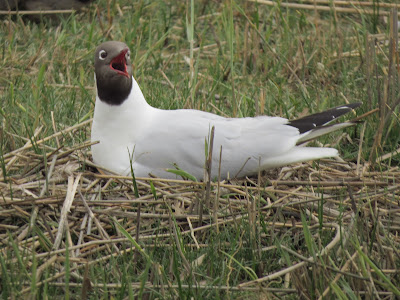A pair of GADWALL
Today there wasn't too much out on the mere, just a couple of pairs of LITTLE and GREAT CRESTED GREBES. But towards the left of the hide, just to the back of the mere there was something much rarer. For there was a singing SAVI'S WARBLER. This bird is a real rarity with maybe five pairs in the whole country. They like ginormous reedbeds, the kind that is quite rare in this country, but of which we have several in Suffolk. Being reedbed birds they are skulking and hard to find, and although I heard it I did not see it. Their song is monotonous a one note call likened to a fisherman's reel.Late April is a great time to visit Minsmere, and every birdwatcher should have this reserve etched in their calendar. With so many migrants passing through the country at the moment something rare is always bound to show up. Today's rare migrant was a RING OUZEL at the North Wall, feeding on the short heathy grass amongst the rabbits. Its a relative of our blackbird, although its much rarer, exclusively nesting in mountainous terrain, whilst wintering in North Africa. Its plumage is slightly different with a white throat patch, and it isn't so uniformly black.
Looking over West Scrape to Sizewell Power Station
The most common bird is the BLACK HEADED GULL, this most ubiquitous of birds has several thousand birds breeding here, with smaller numbers of the closely related MEDITERRANEAN GULL mixed amongst them, similar but with a subtly different plumage.
There has also been a massive influx of SANDWICH TERN this Spring, with several hundred present. This is a large tern, about the same size as a GULL, with a black bill and a yellow tip. I haven't seen them here in this large a number before, and maybe they may form a colony here, as there were several mating. They are only sporadic nesters at Minsmere, but when they do nest they do so in large numbers. A handful of COMMON TERN have returned, with red bill and legs, they are more widely spread throughout the country, common like their name. Also present on the South Scrape were a few KITTIWAKE, the true "sea" gull. They nest further down the coast on the Sizewell power plant riggings and just hang out on the scrape.
LAPWING
WADERS are a big presence here on the Scrape during the Spring. LAPWINGS were sitting on eggs in the grassy area in front of North Hide. REDSHANK were everywhere with their melancholic call, truly the sentinel of the marshes. There were the odd pair of RINGED PLOVER and OYSTERCATCHER present, although AVOCET numbers were quite low for the time of year.
April is a good time for migrant WADERS, but only the usual selection was present today. There were around ten BAR TAILED GODWIT, three DUNLIN, two TURNSTONE and one KNOT. At this time of year the waders are in their breeding finery and the GODWITS looked impressive in their brick red plumage.
REDSHANK
Being a large wetland area there are lots of nesting DUCKS of many species, whether breeding on the scrape or the meres tucked away in the reedbeds. A pair of BAR HEADED GEESE was present on West Scrape, that's four species of geese present on the scrape and not one of them has originated naturally, they are all escapees from some collection.
Male REED BUNTING
Minsmere has a wealth of different habitats and as a result there are lots of small birds. Today activity was muted by the strong winds, which dampened down their activity. Two pairs of STONECHAT were on the beach whilst a male WHEATEAR was by the sluice bushes. SEDGE WARBLERS were singing energetically from the reeds, whilst the simple call of the REED BUNTING drifted over the reeds.A large SAND MARTIN colony was present in the sandy cliffs by the old car park, several hundred strong, and birds were busy feeding over the reserve, catching insects on the wing.
Female STONECHAT
Out at sea a GREY SEAL was present close to shore, differentiated from the harbour seal by its different shaped snout. I didn't really see any other mammals except a MUNTJAC in the woods along the road leading to the reserve entrance, but none of the larger deer.Few places beat Minsmere in Spring just for the sheer number of birds. Reserves like this are the great cathedrals of the natural world, and are worth conserving as such. Unfortunately Minsmere is under threat as they plan to expand the nuclear power stations to the south of the reserve. With such an undertaking happening right on its border, Minsmere is going to suffer. To allow this to happen would be one of the biggest mistakes this country has ever endured. The natural world should be treated as something more than just a commodity, something that is just material. It is something that is deep in our souls.



























